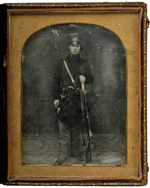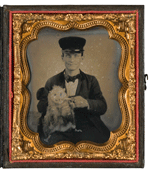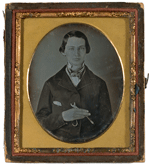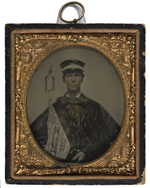|
Cowan's Corner
Propping Up Early Photography
By Wes Cowan
It has been said that “a picture is worth a thousand words,” and in some cases, a picture can be worth a thousand dollars, or more, especially to those interested in collecting early photographs. Since 1839 when the daguerreotype, the first practical form of photography, was invented, both famous historical figures and everyday people wanted to have their pictures taken. While the early portraits of notable individuals such as Abraham Lincoln can sell for several thousands of dollars in today’s market, the early images of often unidentified individuals do not draw as much interest or money at auction, unless of course, the sitter is posing with a prop such as a firearm, a sign, a tool or an animal. In many cases, props not only add historical value to early photographic portraits but also increased monetary value.
Some of the most popular portraits accompanied by props are those of people posing with a weapon such as a shotgun, revolver or knife. Whether it is a Civil War soldier or a cowboy, collectors cannot help but get excited when they come across an early image of someone armed with their weapon of choice. A particular weapon can often help identify what type of sitter the person is, such as a soldier or hunter, and can help date the portrait. In December, Cowan’s featured an early half plate daguerreotype of an enlisted member of the Regiment of Mounted Riflemen armed with an Ames knife made specifically for the regiment, a revolver and a Model 1841 Mississippi rifle. These weapons enhanced the rarity and value of the image.
Political statements were often made by using props in early photographs. This past year, Cowan’s handled a scarce ambrotype of an Abraham Lincoln supporter, identified as a “Wide Awake Marcher.” The sitter wears a black glazed hat and cape and carries a swing-torch, all common aspects of the Wide Awake uniform. A flag hanging from the torch promotes Lincoln for president. Without using props such as the torch and flag, this young, unidentified sitter would have been overlooked, but because he proudly displayed the items, he established his place in history and drew a great deal of interest from historians and collectors alike.
Early occupational portraits of craftsmen, doctors, musicians and firemen exhibiting the tools of their trade are desirable. The sitters who chose to use items like animals, books and toys as props to reveal something about their personal interests also draw interest amongst collectors. In December, Cowan’s featured an ambrotype of a peculiar gentleman holding a live opossum in his lap. A beginning collector can purchase these early photographs of tradesmen for as little as $50 and as much as $1,000, or more. Therefore, if you come across an early image of an individual holding an opossum or a Colt revolver, you should consider investing in the photograph. You might discover that the props included in the portrait literally “prop” up the monetary value and historical significance of the image.
 About the author: Wes Cowan is founder and owner of Cowan’s Auctions, Inc. in Cincinnati, Ohio. An internationally-recognized expert in historic Americana, Wes stars in the PBS television series History Detectives and is a featured appraiser on Antiques Roadshow. He can be reached via email at info@cowans.com. Research by Katie Landrigan. About the author: Wes Cowan is founder and owner of Cowan’s Auctions, Inc. in Cincinnati, Ohio. An internationally-recognized expert in historic Americana, Wes stars in the PBS television series History Detectives and is a featured appraiser on Antiques Roadshow. He can be reached via email at info@cowans.com. Research by Katie Landrigan.
|

Half plate daguerreotype of an enlisted member of the Regiment of Mounted Riflemen, sold for $6,463 in Cowan’s Dec. 2, 2009 American History Auction.

Sixth plate ambrotype of an Abraham Lincoln Wide Awake Marcher, sold for $10,575 in Cowan’s June 24, 2009 American History Auction.

Sixth plate daguerreotype of a young dentist, sold for $294 in Cowan’s Dec. 2, 2009 auction.

Sixth plate ambrotype, “Gentleman Holding Opossum in his Lap,” sold for $382 in Cowan’s Dec. 2 auction.
|